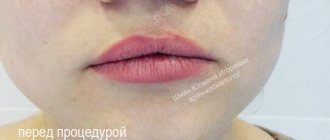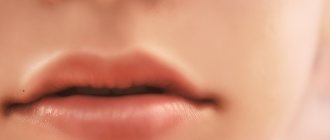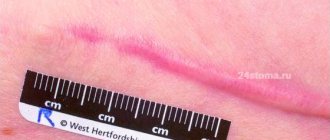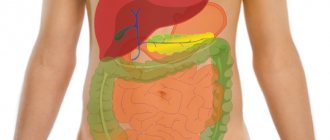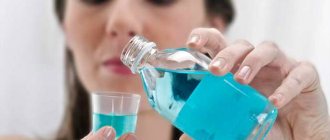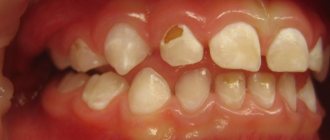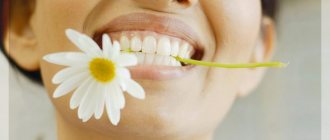Causes of yellowness around the mouth
If problems occur that are characterized by a change in blood circulation, this will entail a change in the color of the facial skin.
Yellowness around the mouth may indicate diseases of the digestive system: liver, stomach, spleen, pancreas .
Green skin around the mouth occurs when there is stagnation in the organs, with serious problems with the liver.
The appearance of an unnatural color around the mouth is often accompanied by anemia, increased fatigue, loss of energy and general malaise.
Important! When red blood cells break down, a substance called bilirubin is formed, and when there is an excess of it, the skin becomes yellow; this condition occurs when too many red blood cells accumulate and the bile ducts become blocked.
Other reasons for the appearance of a yellow or greenish color around the mouth may be:
- disruptions in the cardiovascular system;
- problems with the thyroid gland and endocrine system;
- oncological diseases;
- diseases of the genitourinary system.
Photo 1: Yellowish color of the skin around the mouth often appears due to bad habits and poor nutrition. Source: flickr (bestacnemedicine02).
Perioral dermatitis: symptoms
Symptoms of this disease are small round or oval-shaped papules located primarily around the mouth and on the chin. In some cases, papules, as mentioned above, can be found on the wings of the nose, on the bridge of the nose, on the temples and cheeks, as well as around the eyes. In some cases, papules may be filled with clear fluid.
The color of the papules, depending on the stage of the disease - exacerbation or remission - can vary from pale pink with a bluish tint to bright red. In some cases, papules are accompanied by hyperemia (general redness) of the skin, or may not cause a change in skin color. A distinctive feature of this type of dermatitis is considered to be a characteristic (light) strip of healthy skin around the mouth, which can be up to 4 mm wide. In turn, the localization of papules can be different - from single formations to groups of several pimples with clearly defined edges. In the case of a large number of papules located nearby, the skin becomes rough, which is felt well when touched.
Also, symptoms of perioral dermatitis, especially during an exacerbation of the disease, may include:
- dryness and tightness of the skin;
- skin itching;
- burning.
However, in a large number of cases, patients do not observe or experience any additional concern with dermatitis.
The sooner you start treating oral dermatitis on the face, the easier and faster it will be cured. That is why, when you detect the first signs of a possible disease, you must seek advice from a dermatologist.
.
Initial appointment
An initial appointment with a specialist involves a thorough examination of the patient, as well as drawing up a preliminary medical history (recording complaints, symptoms, concomitant diseases), which allows making preliminary assumptions regarding the cause of the disease. Additionally, tests and other diagnostic measures may be prescribed to clarify the clinical picture and understand how to treat oral dermatitis on the face.
Diagnostics
Diagnosis of this type of dermatitis is necessary as a way to differentiate from diseases with similar manifestations - eczema, herpes simplex, rosacea, etc.
Diagnostic measures in this case include:
- dermatoscopy: allows you to assess the general condition of the skin, the degree of development of pathology through a thorough examination of neoplasms;
- scrapings of skin material from the affected areas: bacterial culture of the test material makes it possible to determine the presence and type of infection (for example, candida);
- Allergy tests for staphylococcus and streptococcus: also allow you to determine the sensitivity of the skin to these agents and identify their presence.
Treatment plan
If the tests confirm the initially suspected diagnosis of oral dermatitis, the treatment prescribed by a specialist will be comprehensive (using ointments and other medications, as well as diet) aimed at eliminating the manifestations of the disease on the face.
The impact on perioral dermatitis on the face when developing a treatment regimen involves two successive stages leading to the gradual disappearance of the rash:
- At the first stage, it is necessary to completely abandon cosmetics (primarily decorative cosmetics) and ointments with corticosteroids. The latter are most often recommended to be discontinued gradually, reducing the dose and quantity, otherwise the so-called “withdrawal syndrome” may occur, which leads to an exacerbation of all existing symptoms - redness, swelling of the face, burning, itching. At this stage, it is most often assumed to use antihistamines (which relieve itching and burning), as well as herbal medications to relieve local inflammation. Additionally, reflexology can be used, which is an effect on active points on the skin of the face, either by simple pressure or with the help of special needles, to reduce the unpleasant manifestations of dermatitis.
- Second stage: after the acute phase of the disease passes, the patient is prescribed antibiotics, which are designed to destroy the infection and are selected taking into account the infectious agent. Antibiotics are taken only under the supervision of a doctor, who has the ability to adjust their composition and dose taking into account the patient’s body’s reaction to them. Particular care should be taken when treating oral dermatitis during pregnancy: in this case, taking antibiotics is contraindicated, and full treatment is possible only after the birth of the child (normalization of hormonal levels is also important). During pregnancy, only partial relief of the symptoms of the disease - burning, itching, etc. - is possible with the use of medications that are safe for the fetus. The same applies to therapeutic measures for dermatitis in children: treatment in this case can only be carried out under the supervision of a doctor, otherwise it can harm the child’s health.
In addition to the described methods of influence, the patient may be recommended:
- strengthen the immune system and take vitamins;
- establish intestinal microflora;
- adhere to a diet: a diet for this type of dermatitis involves avoiding fried, fatty and spicy foods, increasing the amount of vegetables and fruits consumed, and preferring boiled rather than fried foods. During the period of taking antibiotics, you must completely abstain from alcohol.
Treatment result
Most often, if you follow medical recommendations, it is possible to cure perioral dermatitis. In some cases, a course of treatment is assumed rather than a one-time treatment. In this case, taking antibiotics can usually last quite a long time (several weeks), and the overall course of treatment can last from several months to a couple of years.
Prevention
Because dermatitis is a multifactorial disease with an unidentified underlying cause, preventive measures include the following:
- careful use of cosmetics, primarily foundations, as well as ointments based on corticosteroids;
- compliance with personal hygiene measures;
- strengthening the immune system (taking vitamins, reducing psychophysical stress, etc.);
- proper nutrition with plenty of fruits and vegetables;
- monitoring the state of the digestive system;
- control of hormone levels, especially during pregnancy.
When the first signs of the disease appear, you should not wait long, you must seek advice from a specialist, undergo an appropriate examination and begin therapy, since in order to achieve the best results, treatment of oral dermatitis must begin as early as possible - in this case it can be cured in a relatively short time .
You can make an appointment with a specialist at the Energo clinic either by phone or by using a special form for registering patients on the clinic’s website.
Take care of your beauty and health!
Diseases associated with yellowing of the skin around the mouth
If increased breakdown of red blood cells occurs, the liver does not have time to process them and yellow pigment accumulates. If it becomes visible on the skin, then this indicates jaundice. The disease is characterized by yellowing of the tongue and whites of the eyes.
Inflammation of the pancreas and hepatitis will also give yellowness to the skin.
This is interesting! With false jaundice, the mucous membranes are not stained.
But yellowness can appear with constant consumption of vegetables and fruits containing a lot of carotene, as well as after the use of certain medications.
A green complexion or area around the mouth can occur with the following diseases:
- severe intoxication;
- liver cirrhosis, any form;
- oncology; kidney diseases.
A violation of the normal coloring of the skin of the face requires an immediate response ; some situations can be fatal to the body.
What measures need to be taken
Bilirubin in excess is very dangerous for the human brain .
Important! If the skin suddenly changes its color to yellow, green, you should urgently call a doctor. While waiting, you can take some sorbent, for example, polysorb, activated carbon.
If the changes occurred gradually, the help of a doctor is also necessary. You need to take the following measures yourself :
- reconsider the diet, perhaps unreasonably high consumption of beets, carrots, pumpkins;
- find out about all the side effects of the medications you are taking;
- quit smoking;
- establish a normal daily routine;
- Lead a healthy lifestyle, skin cells should be saturated with oxygen.
Photo 2: Along with this, consultation with a doctor is required, since the causes of changes in facial skin color can be very serious, requiring immediate intervention. Source: flickr (andranik).
Homeopathic treatment
| Purpose | Drugs |
| For the treatment of liver and gallbladder diseases, relieves pain in the epigastric region and other dyspeptic disorders. |
|
| For acute and chronic diseases of the liver and gall bladder, it can also help with skin diseases: dermatitis, neurodermatitis, etc. Restores the lymphatic system of the gland, acts as a detoxification agent. |
|
| To cleanse the liver. |
|
| With atrophic cirrhosis, which is accompanied by pain in the right hypochondrium. |
|
| For any liver pathology. |
|
| For pain in the right side and flatulence. |
|
| With such a phenomenon as congestive liver, which is manifested by necrosis of hepatocytes, and is usually accompanied by heart failure. |
|
Possible causes of age spots
Among the main reasons that cause the appearance of unsightly age spots on the face are the following:
- Hereditary predisposition. Such spots include, for example, nevi, which are formed due to the uneven formation and distribution of melanin in skin cells. Most often they are beige or brown in color. Every person has a certain number of congenital age spots. However, if they begin to enlarge, become injured, or there are too many of them, this can lead to the development of cancer, and therefore such spots must be removed in a timely manner.
- Exposure to ultraviolet rays. Prolonged and heavy sun exposure often leads to the formation of age spots, such as freckles. This is due to excess melanin production when exposed to ultraviolet rays. In this case, it is possible to avoid the appearance of age spots if you use protective creams before sunbathing. This is perhaps the only reason that you can eliminate on your own, although consulting a good cosmetologist in this case will not be superfluous. Currently, there are a lot of drugs that can eliminate or “whiten” such age spots very quickly.
- Use of low-quality cosmetics and perfumes . The appearance of age spots is associated with exposure to harmful components that are part of such products and directly affect the skin. Treatment will be required here.
- Folic acid deficiency . Occurs in the body during certain diseases of the circulatory and immune systems. As a result, skin changes are observed, which are manifested by the appearance of age spots. Folic acid may be insufficiently supplied from food and may be observed in folate deficiency anemia, pregnancy and a number of other conditions. A lack of vitamin C and copper in the body can also cause the appearance of age spots.
- Age-related skin changes . They appear after 50 years and are signs of age. These spots are called lentigo spots. They occur in areas that are most frequently exposed to ultraviolet radiation, namely the face and hands. Their occurrence is associated with biological changes occurring in the skin; menopause and increased estrogen levels cause an increase in the number of such spots.
- Hormonal changes . They are one of the most common causes of age spots.
Very often, so-called chloasma occurs on the face, abdomen and around the nipples and genitals of pregnant women. The formations are characterized by a very specific location. For example, on the face they are usually on the bridge of the nose, temples, chin or upper lip, forming the so-called pregnancy mask. The reason for their appearance is a change in the general hormonal background, which means changes in the content of estrogen and progesterone, which, while expecting a baby, are present in a woman’s body in a different proportion than at normal times.
Chloasma that appears during pregnancy tends to disappear on its own after childbirth. Accordingly, no special therapy is required in this case. But to try to avoid their appearance, you should spend less time in the sun, eat healthy and balanced, and do not experiment with cosmetics. You can lubricate your face and other dangerous areas with special creams with a high content of folic acid, which are available in a wide range today.
Hormonal imbalances are observed not only in pregnant women. Fluctuations in the level of progesterone and estrogen, which occur during the normal physiological cycle in women, can also cause age spots on the face. This is called melanosis, in the formation of which an increase in the level of estrogen plays a significant role, which stimulates the formation of melanin. More often, this problem is typical for brunettes whose skin belongs to the fourth phototype. The spots that form in this case are uneven in shape and are located on the forehead, temples, cheeks, in the area of the upper lip and above the upper lip.
Taking oral contraceptives , as well as topical estrogen, can also cause spots to appear. The appearance of chloasma is accompanied by the onset of menopause. The reason for their occurrence also lies in the level of estrogen and an increase in the synthesis of pigments.
Many serious diseases are also accompanied by an increase in the level of estrogen in the blood and, as a result, the formation of age spots on the face. This may include:
- thyroid diseases that affect hormonal levels in the body;
- ovarian cysts and tumors;
- panhypopituitarism;
- pituitary tumors accompanied by increased production of estrogen;
- pathology of the adrenal glands;
- stress;
- obesity (estrogens are produced by adipose tissue);
- some diseases of the liver and gall bladder.
It is quite difficult to deal with spots that arise due to hormonal disorders. Sometimes it is not enough to identify and eliminate the causes that led to their formation, and in some cases it is difficult to completely get rid of the disease itself. In such a situation, women often resort to the help of cosmetologists to cope with the problem. However, if the underlying cause continues to adversely affect the body, the spots will appear again.
- Features of metabolic processes . Metabolism in the body is very important. Some diseases lead to its disruption. As a result, excess melanin production occurs and pigment spots form. Gallstone disease, hepatitis A, diseases that lead to impaired absorption of vitamins and minerals in the intestines can also cause the formation of age spots.
- Nervous disorders . Stress is, although not the most common, one of the reasons for the appearance of age spots.
